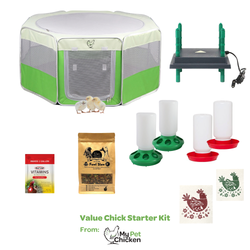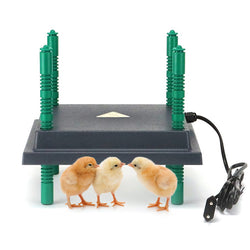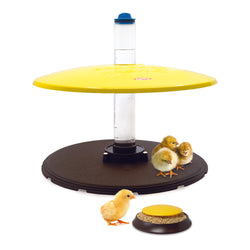Should I get my birds vaccinated?
Back to blog
Here at My Pet Chicken, we offer a Marek's disease vaccination for all baby chicks. Marek's disease is the #1 disease-related killer of chickens. It can cause paralysis, blindness and death in up to 80% of an infected flock. There is no cure for a flock once it has been infected; the only way to prevent the disease is to vaccinate for it within 24 hours of the chick hatching. Learn more about Marek's disease.
Yes, you should get your chicks vaccinated
To be blunt about it, yes. Make the small investment in a Marek's vaccine for your chickens. While in our experience, small, isolated backyard flocks are less prone to infection than larger flocks in general, and you may go years without a problem, when it does strike, you'll sure wish you had listened to our advice.
Marek's Disease does not affect people
And that's good news, right? It doesn't even affect other animals. Avian metabolism is very different, and there are very few ailments that affect both people and chickens. Even the type of lice that commonly bother chickens don't bother people! The vast majority of illnesses people get from chickens come from not washing hands after handling chickens, or improper cooking or preparation of chicken eggs or chicken meat. So while you don't have to worry about Marek's making you sick, it still will be deadly to your chickens.
Ducks and Geese don't get Marek's disease
Thankfully, ducks and geese are less prone to most common poultry diseases and parasites, so they don't need to be vaccinated. Because of that, we do not offer a vaccination for waterfowl.
Still have lots of health-related questions?
You might consider purchasing The Chicken Health Handbook, sold here on our website, in order to inform yourself about health issues more completely.
Yes, you should get your chicks vaccinated
To be blunt about it, yes. Make the small investment in a Marek's vaccine for your chickens. While in our experience, small, isolated backyard flocks are less prone to infection than larger flocks in general, and you may go years without a problem, when it does strike, you'll sure wish you had listened to our advice.
Marek's Disease does not affect people
And that's good news, right? It doesn't even affect other animals. Avian metabolism is very different, and there are very few ailments that affect both people and chickens. Even the type of lice that commonly bother chickens don't bother people! The vast majority of illnesses people get from chickens come from not washing hands after handling chickens, or improper cooking or preparation of chicken eggs or chicken meat. So while you don't have to worry about Marek's making you sick, it still will be deadly to your chickens.
Ducks and Geese don't get Marek's disease
Thankfully, ducks and geese are less prone to most common poultry diseases and parasites, so they don't need to be vaccinated. Because of that, we do not offer a vaccination for waterfowl.
Still have lots of health-related questions?
You might consider purchasing The Chicken Health Handbook, sold here on our website, in order to inform yourself about health issues more completely.



